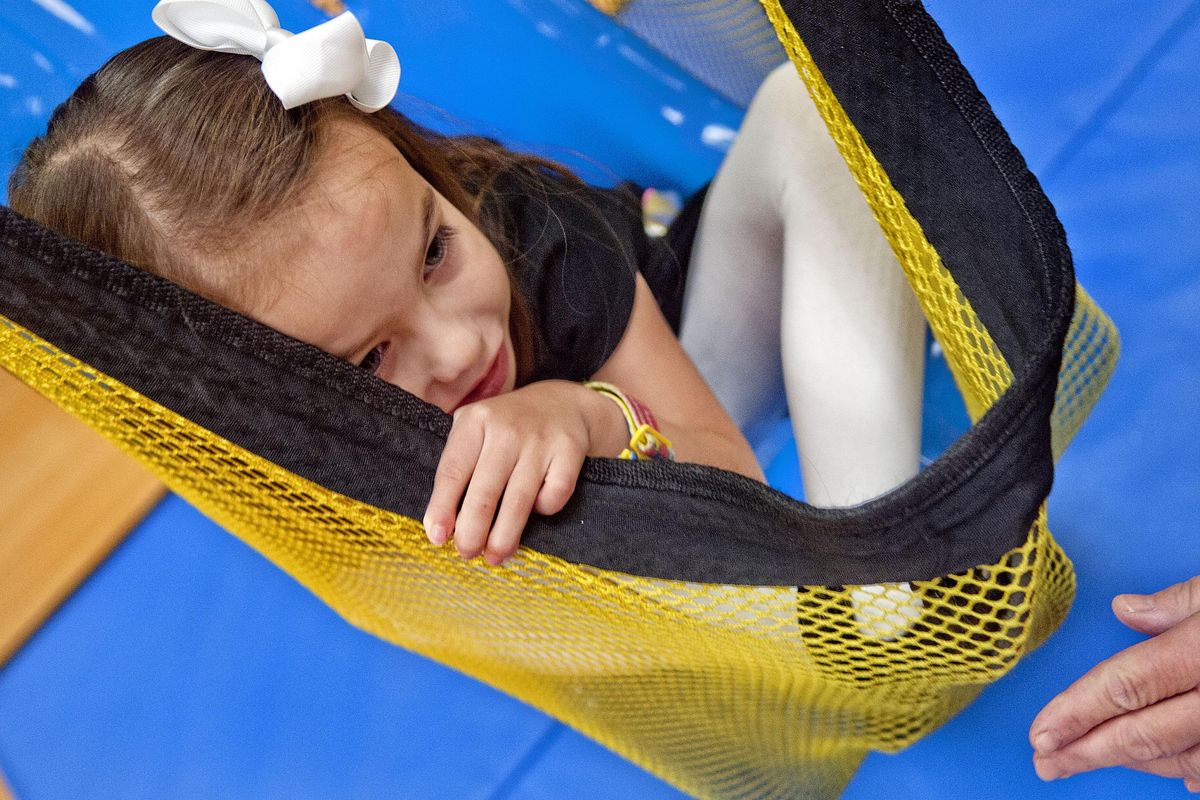Awareness grows around sensory processing issues
Jenna Roberts, 4, is pushed on the therapy swing by Barb Wellman, occupational therapist at Kootenai Health Rehabilitation Services in Coeur d’Alene on Nov. 1. Jenna is receiving therapy due to complications stemming from severe autism. (Kathy Plonka / The Spokesman-Review)Buy a print of this photo
Certain classrooms at Ramsey Magnet School of Science in Coeur d’Alene offer soft lights and special seating that let kids wiggle while learning.
Chuck E. Cheese locations in Spokane and Spokane Valley dim lights and noises the first Sunday of the month for a sensory-friendly morning for children with autism and special needs. At Spokane Public Schools, some classes have flexible seating options — from exercise balls to specialty cushions — and softened lights.
And soon, Kootenai Health in Coeur d’Alene will add a sensory integration room to expand outpatient therapy for pediatric patients.
Awareness is growing about sensory processing issues among children, say Spokane and Coeur d’Alene occupational therapists. Professionals note many adults also have coping mechanisms around sensory needs, often to stay focused, from chewing on a pencil to tapping a foot.
“Everybody has sensory needs in order to regulate themselves in everyday life,” said Kimberlee Wassink, a Kootenai Health outpatient occupational and speech therapy supervisor. “You see people who fidget and click their pen, or tap their leg as they sit.”
Children with sensory processing disorders can have difficulties in response to touch, movement, sight, sound, smell and taste. Kids might overreact or underreact to what others consider mild stimuli.
Sensory issues are common among kids who are diagnosed with autism or attention deficit hyperactivity disorder, known as ADHD, among other conditions. Some kids shut down completely and disengage.
“It can affect daily living, how well they sit in class, foods they eat or their hygiene needs based on their sensory processing needs,” Wassink said. It may be that children only tolerate loose-fitting or tight-fitting clothes, “or whether they wear shoes and socks, or not.”
Don Kammerer, a St. Luke’s Rehabilitation Institute occupational therapist, has worked with children for 20 years and specializes in working with kids who have sensory processing disorders. While different diagnoses including autism and ADHD can be a factor, they’re not always, he said.
“You can have the condition without having any of the diagnoses,” Kammerer said. The condition in children usually is identified between the ages of 2 and 7.
As for the some of the why, he added, “It’s a developmental milestone that hasn’t quite integrated; that’s the theory behind it. It causes some holes in the perceptions around us.”
Difficulties in processing the senses can impact a child’s development, learning and the self-managing of behaviors, said Sue Donaghue, Kootenai Health’s director of rehabilitation services. One in 20 people experience inefficiency in sensory processing.
Occupational therapists will work with children using “sensory integration therapy” on an outpatient basis to help kids in their responses to stimuli specific to how they struggle.
“Sensory integration therapy helps children normalize the way they’re taking the input in, and it then helps them do those things like dressing or functioning in a classroom,” Donaghue said.
Kootenai’s Pediatric Rehabilitation Services will use a $25,000 gift to open a sensory integration room to expand outpatient therapy for children in the spring. Of the program’s 956 pediatric visits per month, an estimated 75 percent of these patients would benefit.
Such treatment spaces are equipped with a variety of tools based on each patient’s needs, whether that be calming elements, such as calming swing or heavy blanket, or stimulating activity for others.
With the therapists introducing activity often seeming like games, kids can explore and develop sensory skills, but they also can go to options to relax and relieve anxiety.
Kammerer said he tends to use obstacle courses, slides, scooter boards, and swings, along with techniques “avoiding over-stimulating, or under-stimulating, to reach a balanced, self-regulated state.”
That allows children to listen, focus and engage in age-appropriate activities for longer periods of time and increase awareness of their body in space and surroundings, Kammerer said. As confidence increases, children often have fewer emotional reactive behaviors and frustrations.
He said most Spokane-area pediatric therapy clinics apply sensory integration. Depending on the child, the therapy might help kids develop more social skills, self-care, motor skills, improved attention spans or self-regulating behavior.
According to Donaghue, a sensory integration room will intentionally have a variety of textures, fabrics, toys and sounds adjusted to the individual needs of a child.
Stimulation and input are introduced in a positive, customized approach – sometimes slowly — but for kids who “shut down,” sensory integration techniques might be used to “wake up” their senses through touch, movement, lighting or hearing music.
For home and school, therapists often provide families with a “sensory diet” for a child, Wassink said.
“It’s something they ask families to do to help provide the child with regular sensory stimulating activities, or sensory calming activities, depending on the need,” Wassink added.
“They’ll literally write a recipe, ‘This is what we found that calms your child,’ so every three to four hours we want them to do this. Schools often recognize sensory diets.”
With a sensory diet, one child might need to do jumping jacks for a few minutes, once an hour. Another kid might simply need flexible seating.
“Several of our families have gone so far as to install swings in their homes for their kids or to make accommodations in their clothing or diet,” Wassink said. “Some kids who are hyper sensitive don’t like tags in clothes, so parents will buy clothes without tags or cut them all out.”
Kammerer offers a class twice a year at St. Luke’s for parents and caregivers, on “Children with Sensory Processing Difficulties,” designed to help people better understand various processing issues.
For example, sometimes a sensory issue is related to the proprioceptive system, which is what governs positioning of the body.
“When a child’s sensory system is seeking more proprioceptive input, we’ll see sensory-seeking behaviors,” he said. That can mean a child who seeks out jumping, bumping and crashing activities, and kicking feet while sitting on a chair.
In schools, one approach than can help is use of exercise bands, so kids who are seated can use them to move legs and kick against the bands as an option for motion while still learning, said Franklin Day, Spokane Public Schools director of special education.
It’s also not unusual for classrooms to encourage all children to move around more and use special seating like T-stools for rocking, Day said. At Hutton Elementary, at least three teachers have gone solely to varied seating options open to every student.
“Teachers are taking the initiative, knowing students are diverse,” he said. “Not everyone can work well all day sitting, so having options are beneficial to all students.
“I know a lot of our teachers have light covers intentionally to filter light or reduce the glare, and some are using lamps as an alternative light source. All of our new schools have varied-level fluorescents.”
Sometimes, teachers lower lighting initially in response to kids with sensory issues, but then they decide to continue the practice.
“Personally in my work space, I don’t have the overhead lights on,” Day added. “It’s just easier for me. Students don’t always have that option. They rely on teachers and other adults.”


